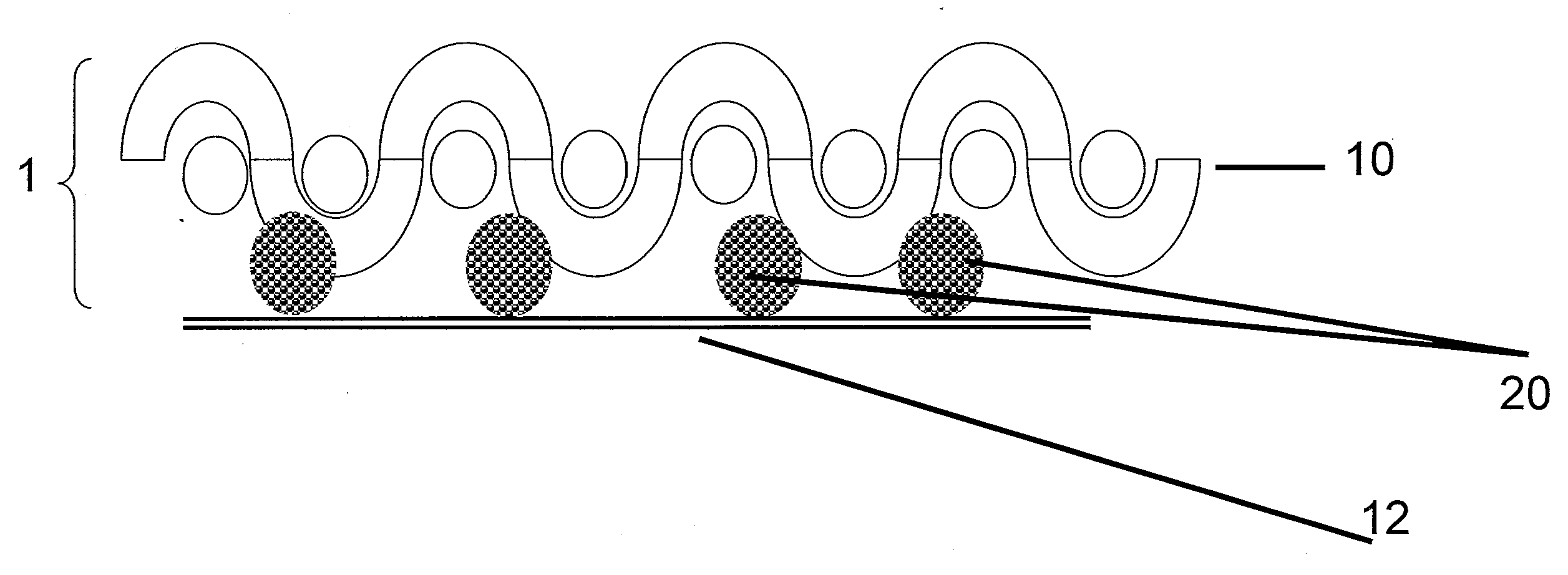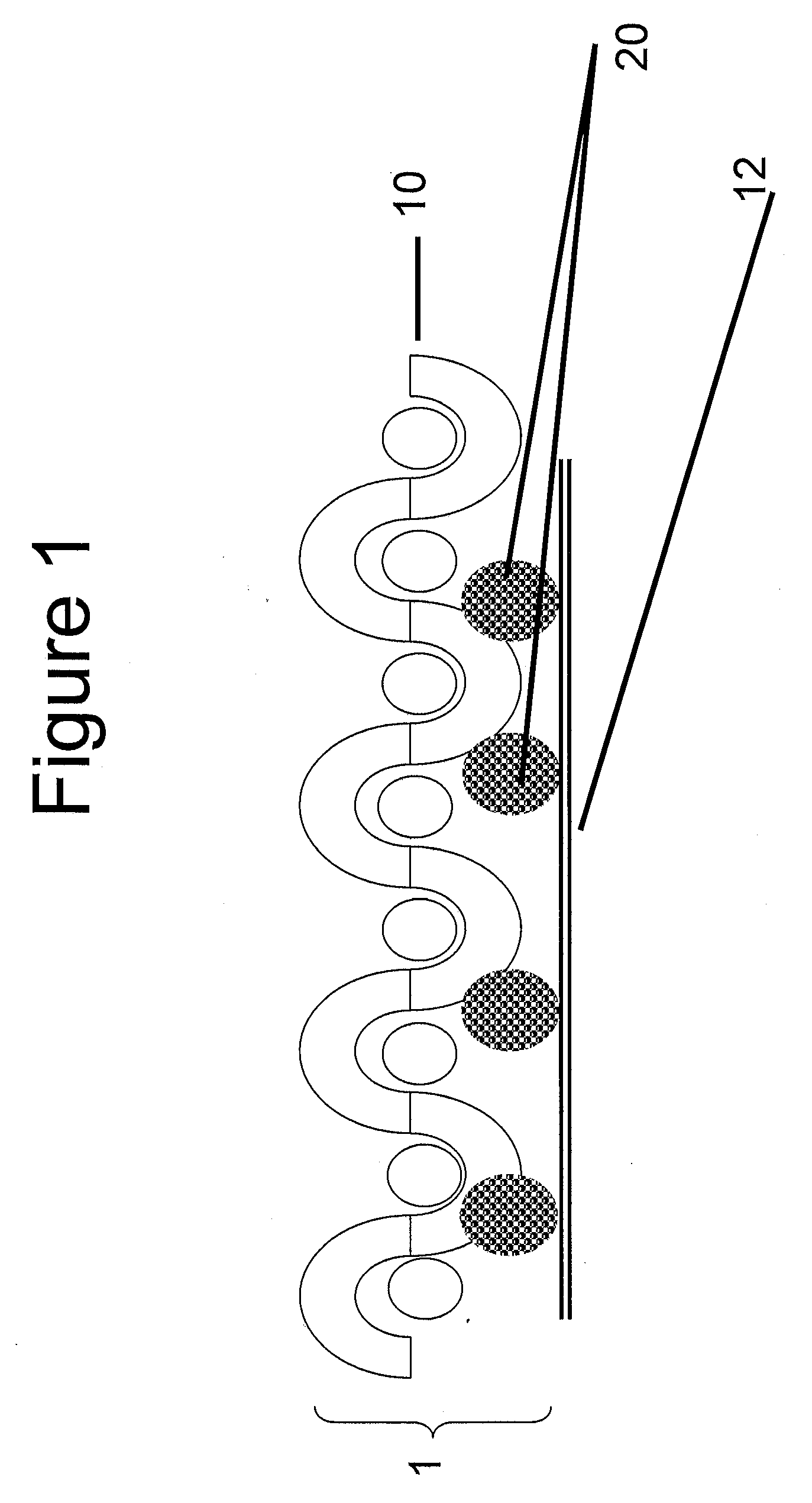Thermally protective materials
a technology of thermal protection materials and protective layers, applied in protective garments, synthetic resin layered products, animal housings, etc., can solve the problems of adversely affecting the user's heat stress burden, and achieve the effects of increasing the thermal protection performance of textiles, liquid protection properties, and flexibility
- Summary
- Abstract
- Description
- Claims
- Application Information
AI Technical Summary
Benefits of technology
Problems solved by technology
Method used
Image
Examples
example 1
[0058]A textile comprising active insulation was prepared as follows. Defender™, a Nomex® based woven fabric weighing 7.5 oz / yd2 available from Southern Mills, Inc was coated with discrete dots of the polymer resin-expandable graphite mixture 2 by a gravure roller (at about 100° C. with a pressure of about 40 psi) in such a manner as to provide coverage of approximately 32 percent on the surface of the fabric, with a laydown of about 35 grams per square meter (gsm). The gravure roll had a round dot pattern with a cell depth 1200 um, cell opening of 2500 um, and a spacing of 2500 um. The coated fabric was allowed to cure at 50% RH and 23° C. for 48 hours.
[0059]Samples of the textile coated with the polymer resin-expandable graphite mixture 2 were tested for thickness change according to the method described herein. After oven exposure the polymer resin-expandable graphite mixture increased in thickness by 1500 μm and did not flake off the substrate.
[0060]Samples of the textile coated...
example 2
[0062]A laminate comprising a Nomex face fabric, a convective barrier and having active insulation therebetween was prepared as follows.
[0063]A laminate was made using a 3.3 oz / yd2 Nomex IIIA plain weave face fabric, and Convective Barrier 1. The laminate was constructed by printing discrete dots of polymer resin-expandable graphite mixture 1 onto the Convective Barrier 1 in a manner according to Fabric Example 1. The convective barrier was then adhered to the 3.3 oz / yd2 Nomex IIIA woven using a nip at a pressure of about 30 psi. The resultant laminate was a two layer laminate comprising the convective barrier and the Nomex IIIA woven flame resistant face textile layer, and active insulation therebetween. The laminate was then taken up onto a steel drum under tension and allowed to cure for about 48 hours at greater than about 50% relative humidity.
[0064]Samples of material were evaluated for flammability, CLO and MVTR according to the methods described herein. The samples tested as...
example 3
[0066]A laminate was prepared comprising a Nomex face textile, a convective barrier and active insulation therebetween, and further comprising a aramid backer textile.
[0067]The two layer laminate from Example 2 was further processed by applying PR1 in a discrete dot pattern to the exposed convective barrier face (on the side opposite the Nomex IIIA woven face textile). A 1.7 oz / yd2 aramid backer woven textile layer was then adhered to the two layer laminate by feeding the adhesive printed two layer laminate and the aramid backer through an additional nip. The prepared three layer laminate was then taken up onto a steel drum under tension and allowed to cure for about 48 hours at greater than about 50% relative humidity.
[0068]Samples of the material were evaluated for CLO and MVTR according to the methods described herein. TPP of the samples was evaluated by orienting the material so that the Nomex face textile side was exposed to the heat source Results are shown in Table 1.
[0069]Sa...
PUM
| Property | Measurement | Unit |
|---|---|---|
| aspect ratio | aaaaa | aaaaa |
| thickness | aaaaa | aaaaa |
| thickness | aaaaa | aaaaa |
Abstract
Description
Claims
Application Information
 Login to View More
Login to View More - R&D
- Intellectual Property
- Life Sciences
- Materials
- Tech Scout
- Unparalleled Data Quality
- Higher Quality Content
- 60% Fewer Hallucinations
Browse by: Latest US Patents, China's latest patents, Technical Efficacy Thesaurus, Application Domain, Technology Topic, Popular Technical Reports.
© 2025 PatSnap. All rights reserved.Legal|Privacy policy|Modern Slavery Act Transparency Statement|Sitemap|About US| Contact US: help@patsnap.com



